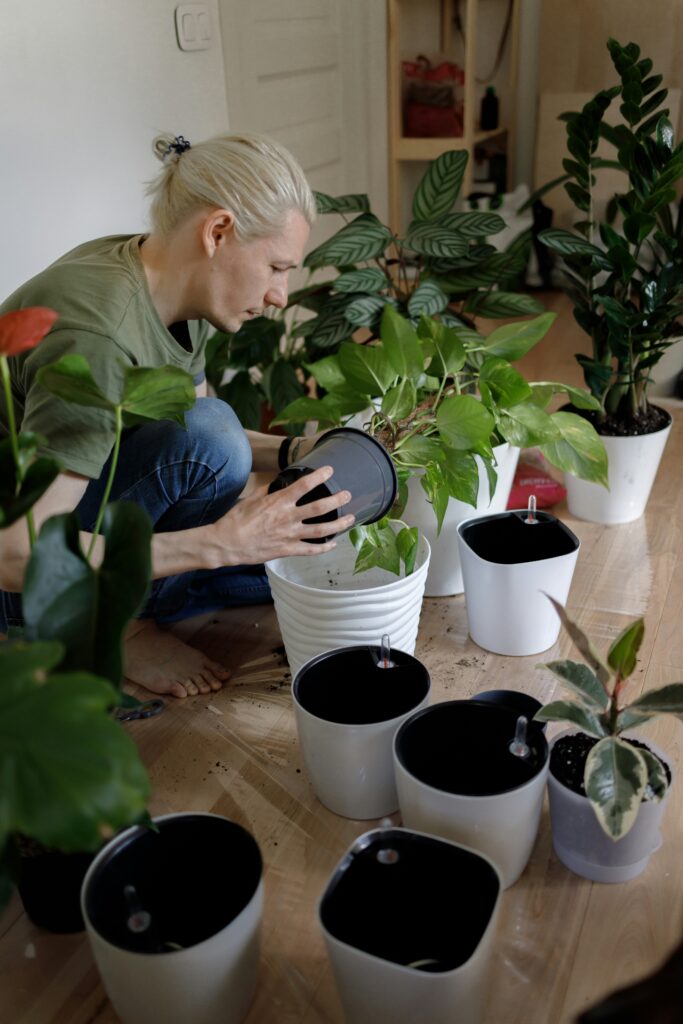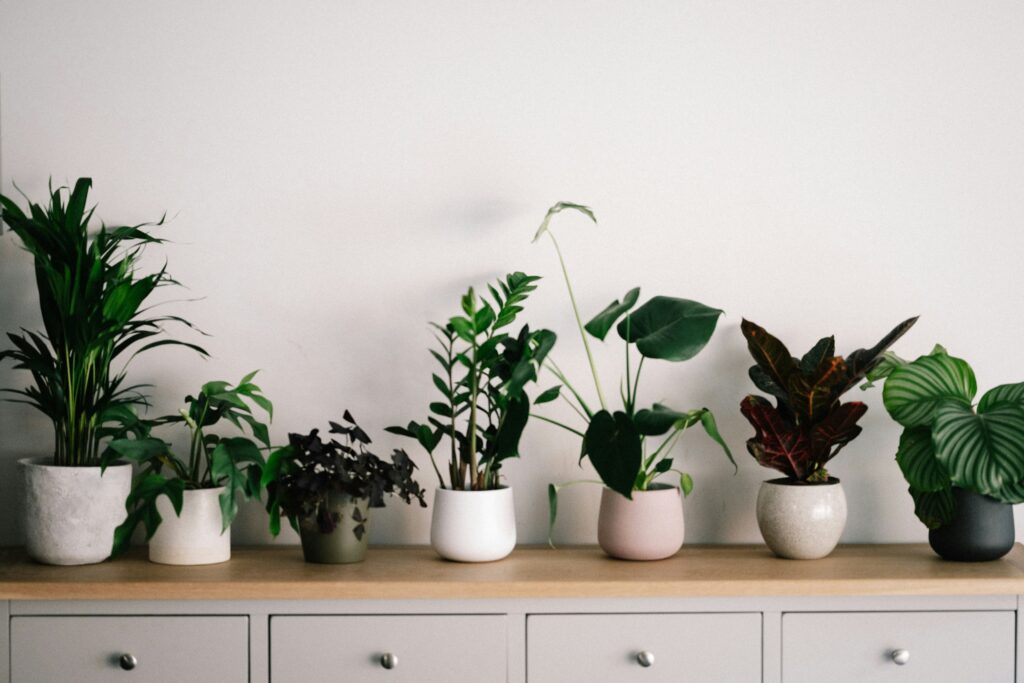Gorgeous, healthy houseplants are the ideal way to add color and life to any interior design. You can effectively cultivate and care for indoor plants, regardless of how many you want or how many houseplants you wish to keep. You can be well on your way to happy houseplants and healthy indoor plants with these easy steps:
Selecting robust houseplants
Healthy plants are the foundation of a thriving “bungalow.” Purchase plants only from reliable and reputable sellers. Be picky when selecting new plants. Examine them carefully for indicators of excellent health, such as regular growth, leaves or buds that are well-formed, stems that are attached securely, and general shape and color.
Avoid buying plants that don’t look their best. Keep away from indoor plants that have small, shriveled growth, mushy stems, droopy or wilted leaves, or damp soil. They can be sick or in need of rescue. Excessive browning, dropping, or yellowing leaves, extended stems, and apparent insect infestations are warning indicators.
Ask your favorite plant store expert for help and advice if you’re unsure about the ideal indoor plants for your space. Almost any home can support the growth of a variety of low-maintenance, easily-grown indoor plants, such as snake plants, golden pothos, and Chinese evergreens.
Think about your space and light.
Photosynthesis is the process by which plants obtain the energy they need to grow, and it is only possible when there is light. While many houseplants require less light than others, even low-light indoor plants become weak and spindly in the absence of sufficient light. Furthermore, pests and diseases are more likely to attack light-starved plants. Before you buy, find out what kind of light the plant requires if you have a specific area or plant in mind.
Plants that require a lot of light generally thrive in front of windows that face south. Put medium-light plants next to windows that face east or three to four feet away from windows that face west. Be mindful of the buildings and trees outside. Less light may enter a blocked southern window than a northern one.
Take your time choosing the right size so your plants don’t outgrow their perfect location too soon. Tiny indoor plants that are easy to move include pileas, baby cactus, and succulents. However, big indoor plants, such as indoor citrus trees, could only be suitable for one or two brightly lit rooms in your house. The greatest indoor hanging plants, such as vining pothos, ivies, and strings of pearls, require room away from traffic so they can hang peacefully.
Harmonize with Your Interior Design
One of the best aspects of houseplant cultivation is the ability to use stylish indoor plants to accentuate your interior design scheme. Plants themselves offer color, texture, and structure to reflect your unique style and complement the newest trends in décor; containers are just one part of the story. There are stylish indoor plants to fit any style, from bohemian to mid-century.
With their striking foliage and captivating personalities, Monstera deliciosa, rubber plants, and fiddleleaf figs all make bold statements. Hardy ZZ plants ranging from gleaming green to deep black fuse color with eye-catching shapes. Vibrant snake plants with hues ranging from midnight green to golden stripes draw attention to vertical lines and angular details. Depending on the amount of light, crotons explode in hues of orange, red, yellow, pink, and purple.

Choose Your Mix of Potting Soil
A proper home for the roots of your indoor plants is the first step towards keeping them looking their best. A premium potting soil mix selection is essential for the well-being of your plants. To prevent your plants from suffering from too much or too little moisture, the perfect potting soil mix helps maintain a constant soil moisture level. To help make sure your plants flourish, the best potting soil mix for indoor plants goes above and beyond the necessities.
Pennington Ultra Grow Potting Soil Mix helps to maintain the aesthetic appeal of your indoor plants as they develop and thrive. This premium potting mix, which is made of biologically active, sustainably sourced materials including Canadian sphagnum peat moss, nutrient-rich earthworm castings, mycorrhizae, and water-holding crystals, creates a living, sustainable soil ecosystem in your own home. An indoor garden that is well-maintained throughout the year will have happy plants and healthy soil.
Give Indoor Plants Enough Water
The leading cause of harm to houseplants and early mortality is improper watering. Brown leaf tips, wilting, and the loss of leaves and blossoms are all results of submersion. Wilting, yellowing or black foliage, and fungal infections like root rot are all signs of overwatering.
When the top one to two inches of your potting soil mix gets dry, give your houseplants a mist of lukewarm water. Use a moisture meter to quickly check the soil before watering, or do it the old-fashioned way by inserting your finger into the ground.
The type of plant, the type of pot, and how warm your home is are some of the variables that determine how often you need to water. For example, compared to porous terra cotta containers that let air pass through the sides, plastic pots hold soil moisture longer.
Manage Pests in Houseplants
Pests that affect houseplants, such as mealybugs, scale insects, and spider mites, can do severe damage to your indoor garden. Certain insects lie latent and emerge later, often when you least expect them, even if you carefully inspect your plants for pests before buying them.
Because of this, it’s critical to look for indications of infestation once a week. Keep an eye out for insects, leaf holes, and gooey materials that pests release while they feed. To protect the other members of your plant family, remove any pests from the afflicted houseplant right away.
When applying pesticides, make sure you carefully read the label’s instructions, especially the ones on when to pick anything edible. For treatment, relocate the troublesome plant outside whenever feasible. Pesticide sprays should not be used inside or in small areas.
Make sure it’s humid enough.
Tropical climates are natural to several common houseplants. Although they can survive in the usually dry air of American houses, they thrive at higher humidity levels. Indications of low humidity in your houseplants include brown leaf tips, bud drop, curling and yellowing of the leaves, and pest susceptibility.
You may easily raise the humidity in your plants by doing the following:
A few times a day, mist your houseplants with a tiny mist of water.
Fill a saucer with polished stones or small pebbles to create a humidity tray.
After adding water to the space between the pebbles, position the plant on top. The air surrounding your plant gets more humid as the water vapor escapes.
Plants should be grouped together.
In this way, the plants mutually humidify.
#1: Light Is Needed by Plants: Natural or Artificial
Not many of us have access to enough natural light to cultivate a garden indoors. Greens and vegetables grow well in front of windows that receive plenty of sunlight. For the best growth, you might occasionally need to add a little artificial light.
Growth will be at its best when there are at least 12 hours of light per day. In the brief winter months, plants sometimes need more lighting.
#2: Allow roots enough space to expand.
Typically, I start plants in a tiny container and move them into a larger pot that will fit them when they reach adulthood. Tiny pots will restrict the plant’s potential size and have an impact on its general well-being and yield.
The lettuce plant in the cup is noticeably smaller than the plant in the tub, as you can see if you look at the plants in the picture below. They were simultaneously started and transferred. The container’s size is the sole changeable factor. Plants will generate more for you when you allow enough room for their roots to spread out.
#3: To avoid root rot, provide adequate drainage.
Good soil is the first step towards good moisture regulation. Invest the extra cash on high-quality potting soil for your houseplants. It will be worthwhile. Quality potting soil will assist in controlling the moisture content of the soil that your plant can access.
Few plants enjoy having their feet wet. I made a cheap system out of plastic dishpans. Jon made holes for drainage in the upper dishpan. Any extra water is caught by a second dishpan underneath. To let the water drain, I sandwiched thin scraps of wood between the dishpans. Although it is within my budget, it is not my ideal system.
#4: Take Growing Temperatures Into Account
Keep the temperature at the proper level for the plants you are cultivating. Plants can withstand significant variations in temperature, but there are a few fundamental factors to take into account.
A temperature between 65° and 70° is good for growing lettuce. For it to grow, the average temperature must be 50°. Growth will be slowed by extreme cold, and bolting will be encouraged by extreme heat.
Conversely, peppers need a temperature of 85° in order to germinate. As long as they don’t freeze, they are exceedingly content to survive in a greater variety of temperatures after the seedling stage.
#5: Strong plants are built by air movement.
Due to their continuous exposure to air movement, plants cultivated outside tend to be stronger. By utilizing fans to provide a light breeze, you may replicate that movement. When the weather is suitable, open the windows in any room where your garden is located to allow fresh air to enter. Drafts are not the same as good airflow.
#6: Apply fertilizer often.
The organic fertilizer that comes from Mother Nature is unavailable to plants kept indoors. All they have are the nutrients you give them.
Certain types of potting soil include slow-release fertilizers, which eliminate the need for fertilization for several months. Every few days, I normally fertilize my plants using an organic fertilizer made specifically for food plants.
Essential supplies are always kept on hand by preppers. This also holds true for fertilizers when cultivating your own home garden. These are a handful that you may find interesting and that are available online.
#7: Everyday Harvest
Your plants will yield more if you harvest them ethically. Lettuce and greens begin to yield their leaves when they are around 4 inches tall. I can pick the tender leaves using the cut-and-come-again technique, leaving the plant to grow. At most, I chop off a third of the plant at a time. The leaves I have picked will be swiftly replaced by new ones from the plant.
Harvesting with the cut-and-come-again technique involves first trimming the outer leaves near the base of the plant, around 1 inch above the ground. For a little while longer, the heart of the plant will keep producing new lettuce. For optimal flavor and texture, harvest in the morning.
#8: Harvest in the fall after spring planting.
Because it is not confined by the seasons, indoor gardening differs greatly from outdoor gardening. All year long, you can plant and harvest.
In conclusion, your indoor garden would benefit from these pointers and techniques. I’m sure you’ll acquire attractive plants if you continue to receive the most education possible. You can wow your loved ones and make your house look beautiful by using these ideas for growing and caring for indoor plants. Recall that the plants you love to nurture and appreciate are the ideal ones to have indoors.
